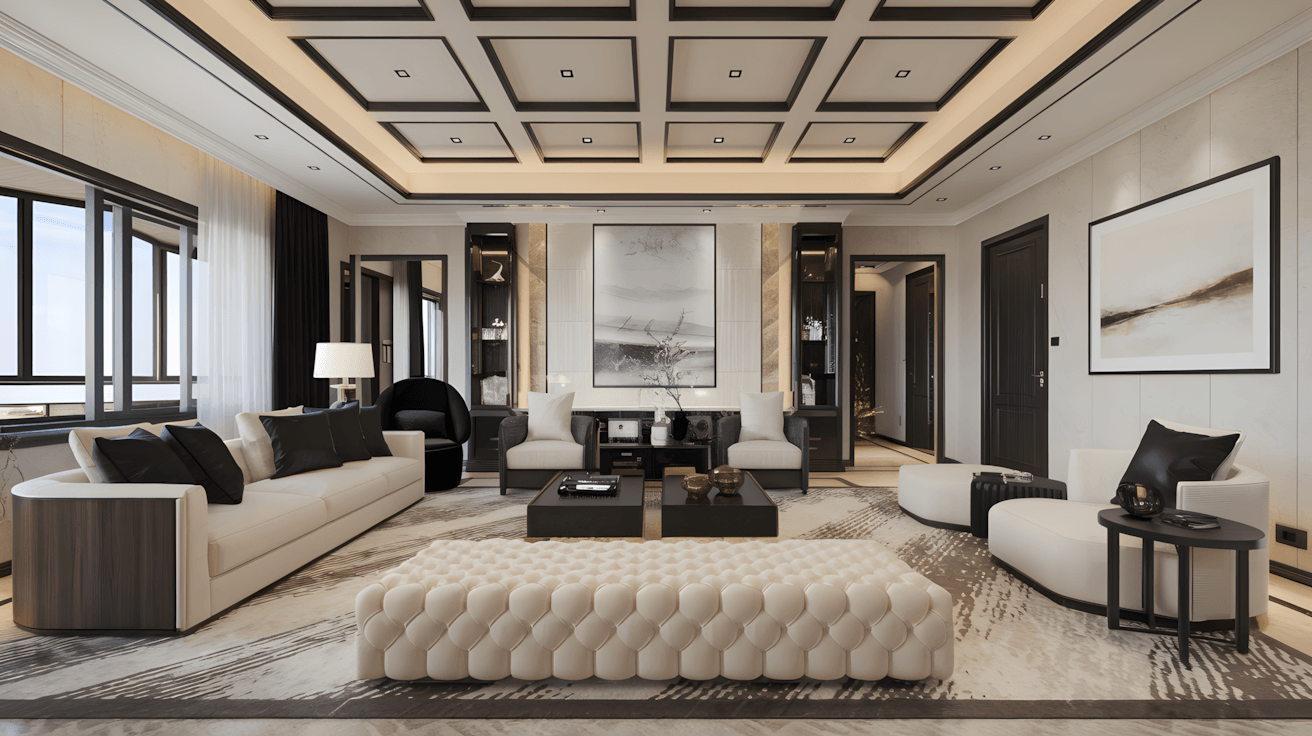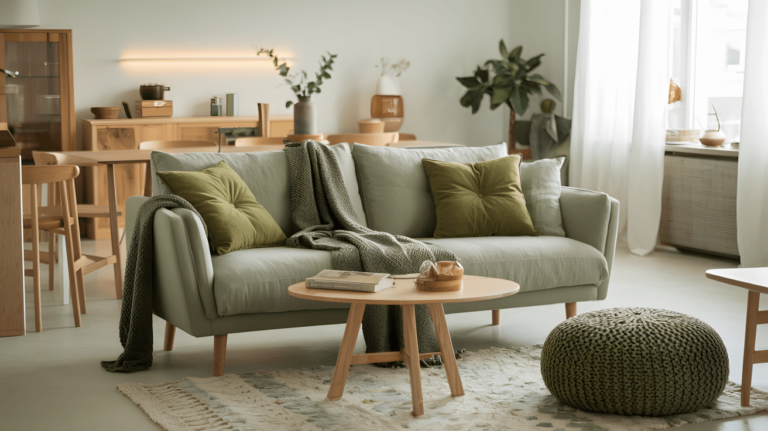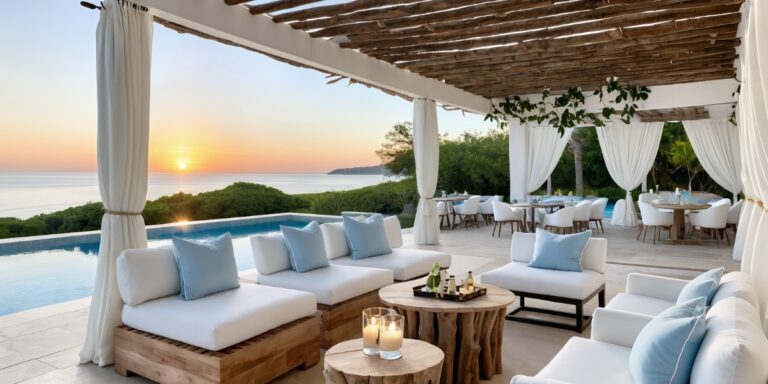In my years of helping homeowners create functional and beautiful living spaces, I’ve learned that the living room truly serves as the central gathering place where daily life unfolds. It’s where families connect, friends gather, and personal style gets expressed through design choices that need to work for real, everyday living.
Through various living room projects, I’ve observed that successful room design depends on balancing aesthetic appeal with practical functionality. I’ve seen Pinterest-perfect rooms that look stunning but don’t work for actual families, and I’ve learned to prioritize designs that remain beautiful while accommodating the realities of daily use.
These 18 living room ideas represent approaches I’ve found effective in creating spaces that genuinely enhance how people live in their homes, each offering solutions for different preferences, room sizes, and lifestyle needs.
Note: For any structural modifications, electrical work, or installations mentioned in this article, always consult with licensed professionals to ensure safety and code compliance.
1. Modern Simplicity with a Neutral Palette
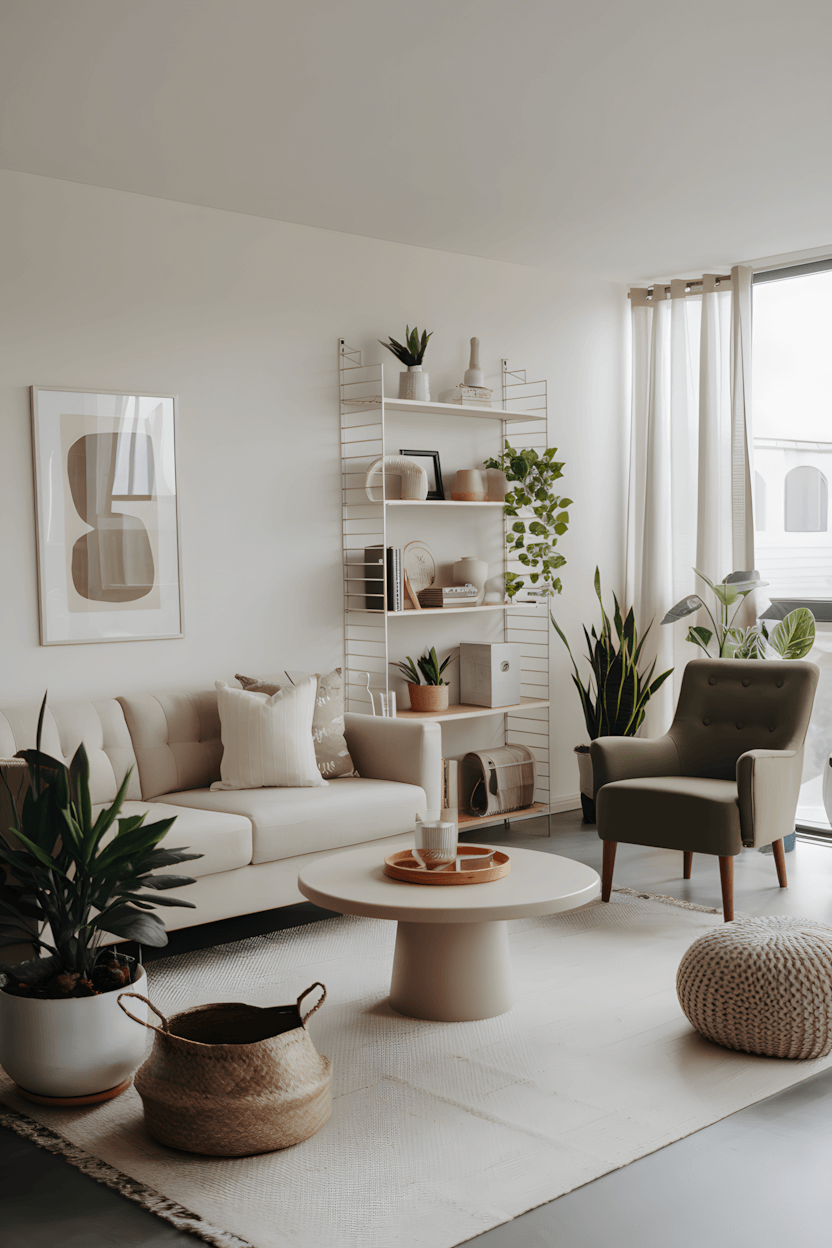
This approach demonstrates how neutral colors can create calm, sophisticated environments. Beige sofas against white walls can provide versatile foundations that adapt to changing preferences over time.
Green accent chairs can add color without overwhelming the neutral base, while round coffee tables often improve traffic flow compared to rectangular alternatives. Abstract artwork can add personality while maintaining the clean aesthetic.
Design consideration: Potted plants and natural textures like knitted poufs can prevent all-neutral spaces from feeling sterile while maintaining the calm atmosphere.
Neutral palette benefits: Neutral foundations typically allow for easy seasonal updates through accessories and artwork changes.
2. Cozy Comfort with Natural Materials
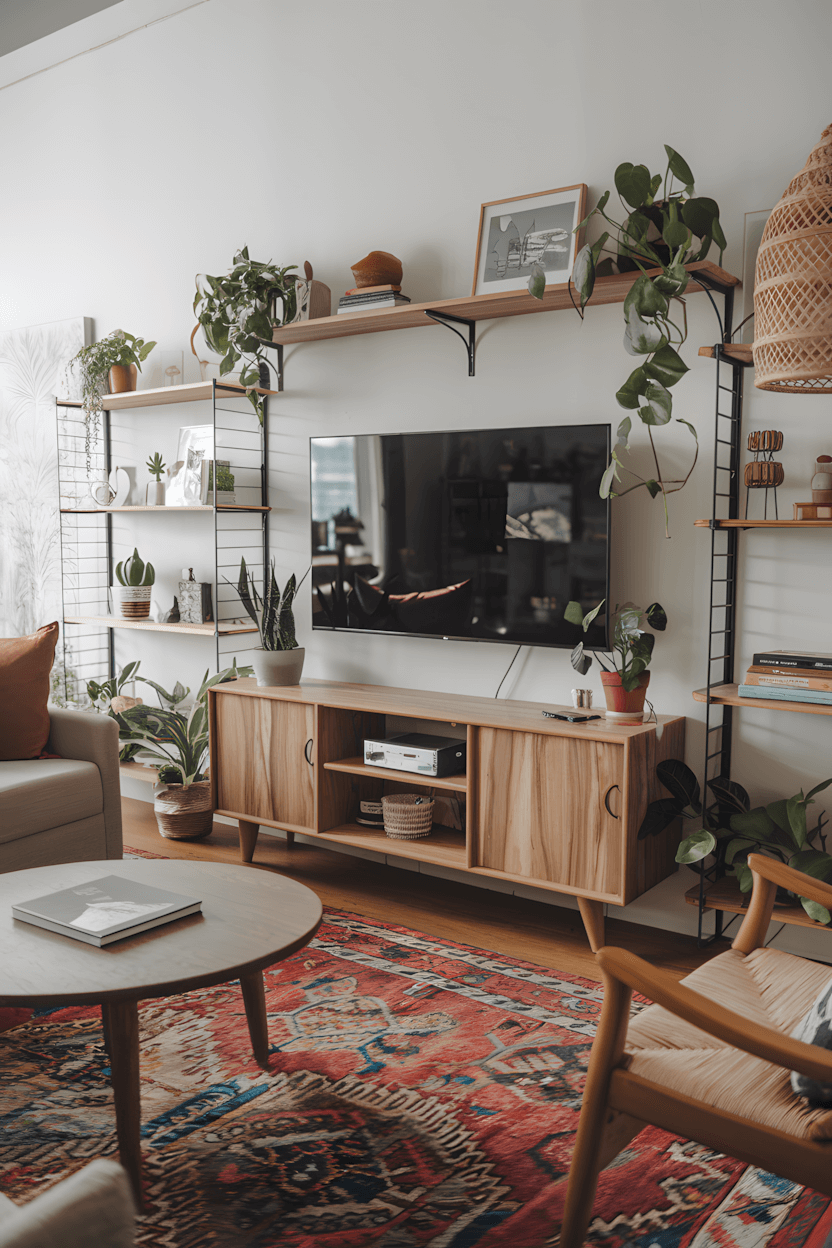
This approach emphasizes warmth through natural materials and textures. Wooden shelving can provide both storage and display opportunities while rust-colored accents add warmth to neutral foundations.
Woven pendant lights contribute natural texture while wooden coffee tables maintain material consistency. Vibrant rugs can add personality and comfort underfoot, particularly important in spaces prioritizing coziness.
Material balance: Mixing different natural materials—wood, woven fibers, natural textiles—often creates rich, layered environments that feel welcoming.
3. Modern Neutral with Organized Display

This approach combines clean aesthetics with practical storage solutions. Wooden floating shelves can provide display space while maintaining minimal visual weight, though proper wall anchoring becomes essential for safety.
Black floor lamps can provide task lighting while woven baskets offer attractive storage solutions. The combination typically appeals to those wanting organized, uncluttered spaces with personality.
Storage integration: Visible storage should look intentional and organized—cluttered shelves can undermine clean aesthetic goals.
Professional installation note: Floating shelves require appropriate wall anchors for the intended load and wall type.
4. Cozy Elegance with Conversation Focus
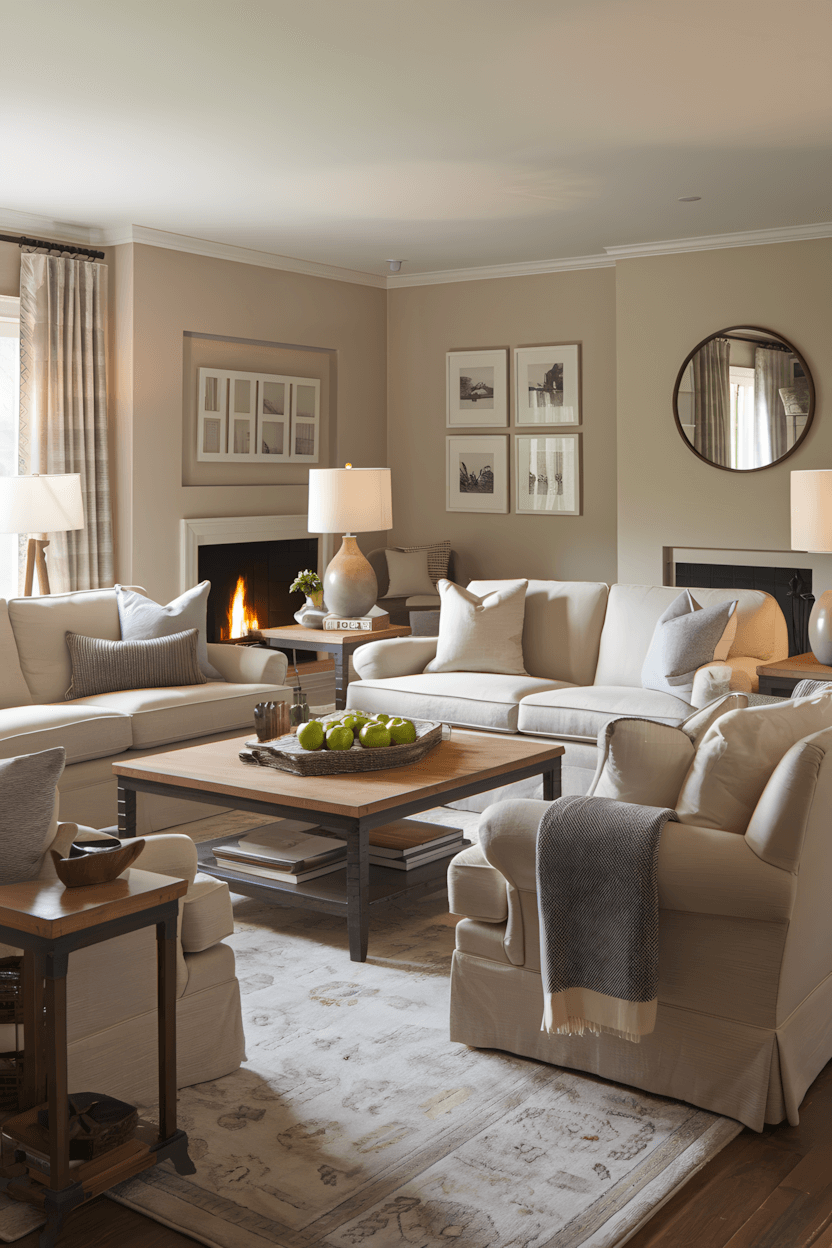
This approach centers around creating comfortable conversation areas. Multiple sofas arranged around central coffee tables can accommodate larger groups while maintaining intimate conversation distances.
Round mirrors can reflect light and make spaces feel larger while table lamps provide warm, ambient lighting. Grid-pattern artwork arrangements can add visual interest without overwhelming the space.
Conversation layout: Seating arrangements typically work best when pieces are positioned within 8-10 feet of each other for comfortable conversation.
5. Rustic Modern with Architectural Interest
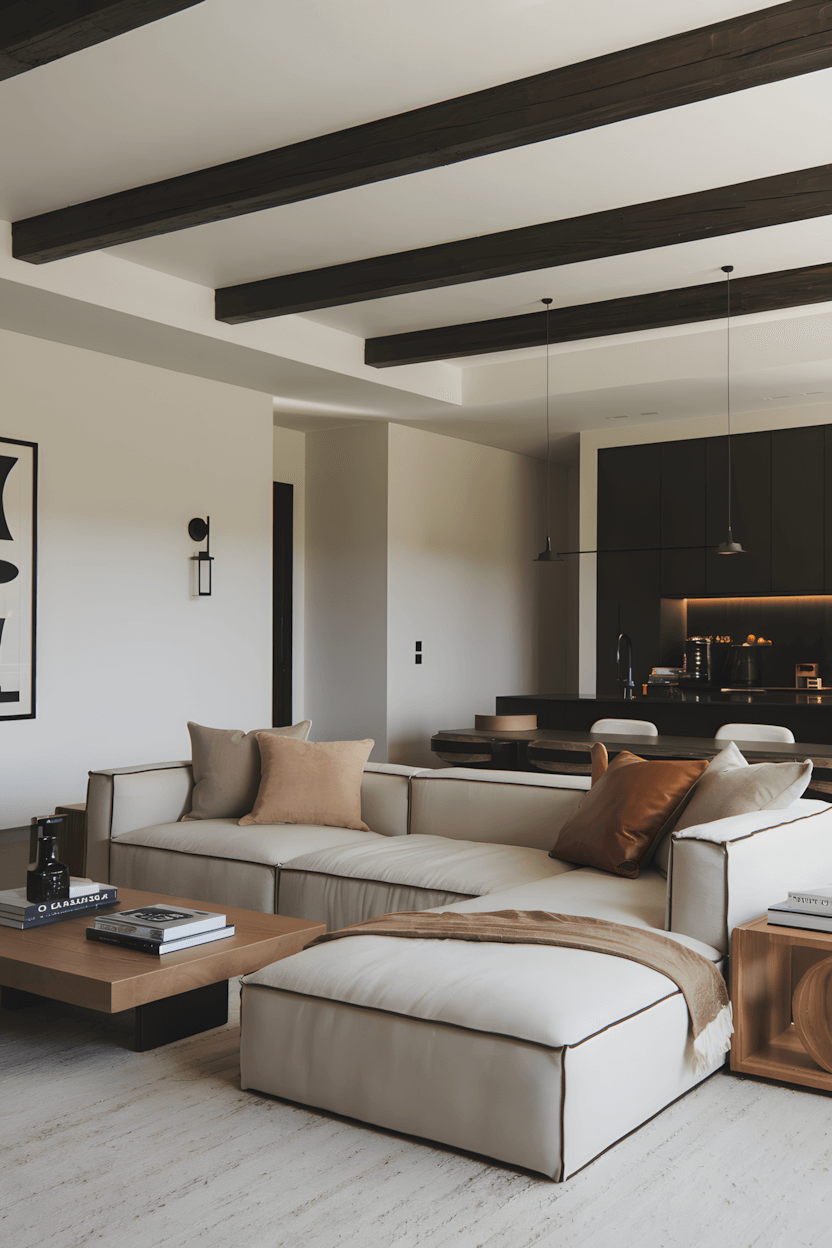
This approach combines contemporary comfort with rustic architectural elements. Exposed wooden ceiling beams can add character and visual interest, though they may require structural assessment for safety.
Sectional sofas can maximize seating while open kitchen connections extend the living space. The combination often appeals to those wanting modern convenience with natural warmth.
Architectural elements: Exposed beams should be properly inspected and treated for structural integrity and pest prevention.
Professional consultation recommended: Exposed structural elements require assessment by qualified contractors.
6. Natural Light Focus with Comfort Layers
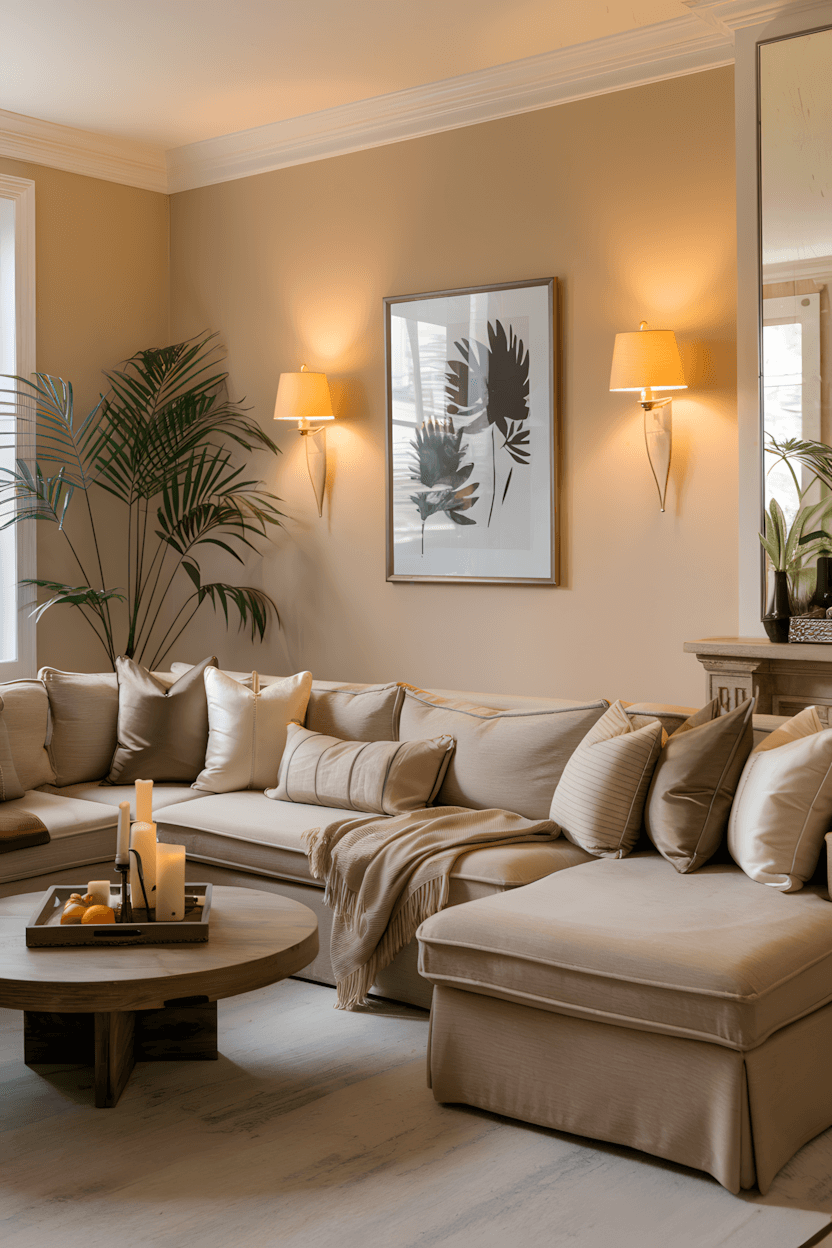
This approach maximizes natural light while creating comfortable environments. Large windows can transform spaces by providing abundant daylight, though glare control may be necessary during certain times.
Sectional sofas with layered cushions and throws can provide flexible comfort while round wooden coffee tables add natural warmth. Palm leaf artwork can reinforce natural themes.
Light management: Large windows may benefit from adjustable window treatments to control glare and privacy while preserving the bright, airy feeling.
7. Spacious Elegance with Balanced Proportions

This approach works well in larger spaces with good natural light. Multiple seating pieces—sofas plus additional chairs—can create flexible arrangements while textured concrete walls add contemporary interest.
Wooden ceiling beams can prevent large spaces from feeling cold while potted plants add life and air quality benefits. The combination typically works for those with substantial room sizes.
Scale consideration: Large rooms often benefit from multiple conversation areas rather than one oversized seating arrangement.
8. Contemporary Comfort with Color Accents

This approach incorporates strategic color through key pieces. Blue sofas can create focal points while maintaining sophisticated appeal, and rust-colored leather chairs add warmth and material contrast.
Wooden floors with light rugs can create visual warmth while built-in shelving provides storage without requiring additional floor space. The combination often appeals to those wanting contemporary sophistication with comfort.
Color strategy: Bold furniture colors represent significant investments, so consider how they might feel over time and in different lighting conditions.
9. Cozy Atmosphere with Fireplace Focus

This approach centers around fireplace warmth and comfort. Gray sectionals with layered textiles can create inviting seating while fireplaces provide both warmth and visual focal points.
Wooden coffee tables and natural accessories can enhance the cozy feeling while potted plants add life to the space. The combination works well for those prioritizing relaxation and comfort.
Fireplace safety: Real fireplaces require professional installation, proper ventilation, and regular maintenance for safe operation.
Professional requirement: Fireplace installations must meet local building codes and require certified professionals.
10. Bold Design with Natural Balance
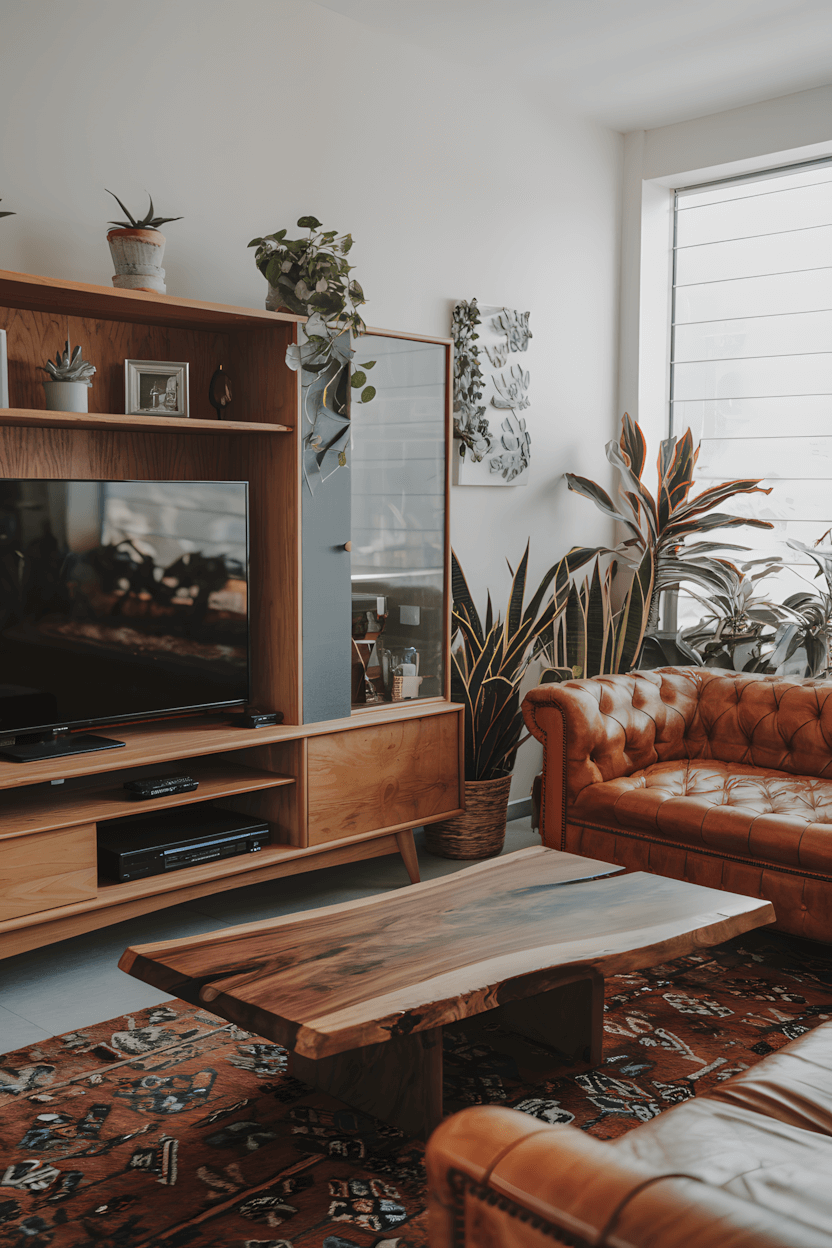
This approach shows how bold colors can work when balanced with natural elements. Orange leather sofas can create striking focal points while wooden entertainment units provide grounding natural textures.
Unique coffee table designs can add artistic interest while scattered plants bring organic elements indoors. Patterned rugs can tie color schemes together while adding comfort.
Bold color balance: Bright furniture pieces often work best when balanced with neutral architectural elements and natural materials.
11. Rustic Elegance with Structural Character

This approach emphasizes architectural features as design elements. Exposed wooden beams and stone fireplaces can create dramatic focal points while providing functional benefits.
White sofas can prevent rustic elements from feeling too heavy while large windows provide necessary light balance. The combination appeals to those wanting impressive, substantial aesthetics.
Rustic maintenance: Natural materials like exposed wood and stone may require periodic treatment and maintenance to preserve their appearance and structural integrity.
12. Serene Color with Natural Warmth

This approach uses calming colors to create peaceful environments. Sage green walls can promote relaxation while maintaining sophistication, and wooden coffee tables add natural warmth.
Wood-burning stoves can provide both heating and ambiance while framed artwork adds personality. Checkered curtains can add pattern interest while providing light control.
Color psychology: Research suggests certain colors like sage green may promote feelings of calm and relaxation, though individual responses can vary.
13. Neutral Modern with Wood Integration

This approach balances contemporary aesthetics with natural material warmth. Wooden accent walls can house entertainment systems while maintaining visual interest, and beige sofas provide versatile foundations.
Recessed lighting can provide even illumination while sheer curtains maximize natural light. The combination typically appeals to those wanting modern functionality with natural touches.
Entertainment integration: Built-in entertainment centers require proper ventilation and cable management for electronic equipment safety.
14. Classic Comfort with Personal Touches

This approach emphasizes comfort and personalization. Multiple sofas can accommodate larger families while wooden coffee tables provide functional surface space.
Decorative mirrors and framed artwork can add personality while patterned rugs and textured accessories contribute warmth. Large windows with privacy treatments balance light and privacy needs.
Personal style: Successful rooms often reflect the inhabitants’ genuine preferences rather than trying to follow every current trend.
15. Rustic Modern Blend with Architectural Focus
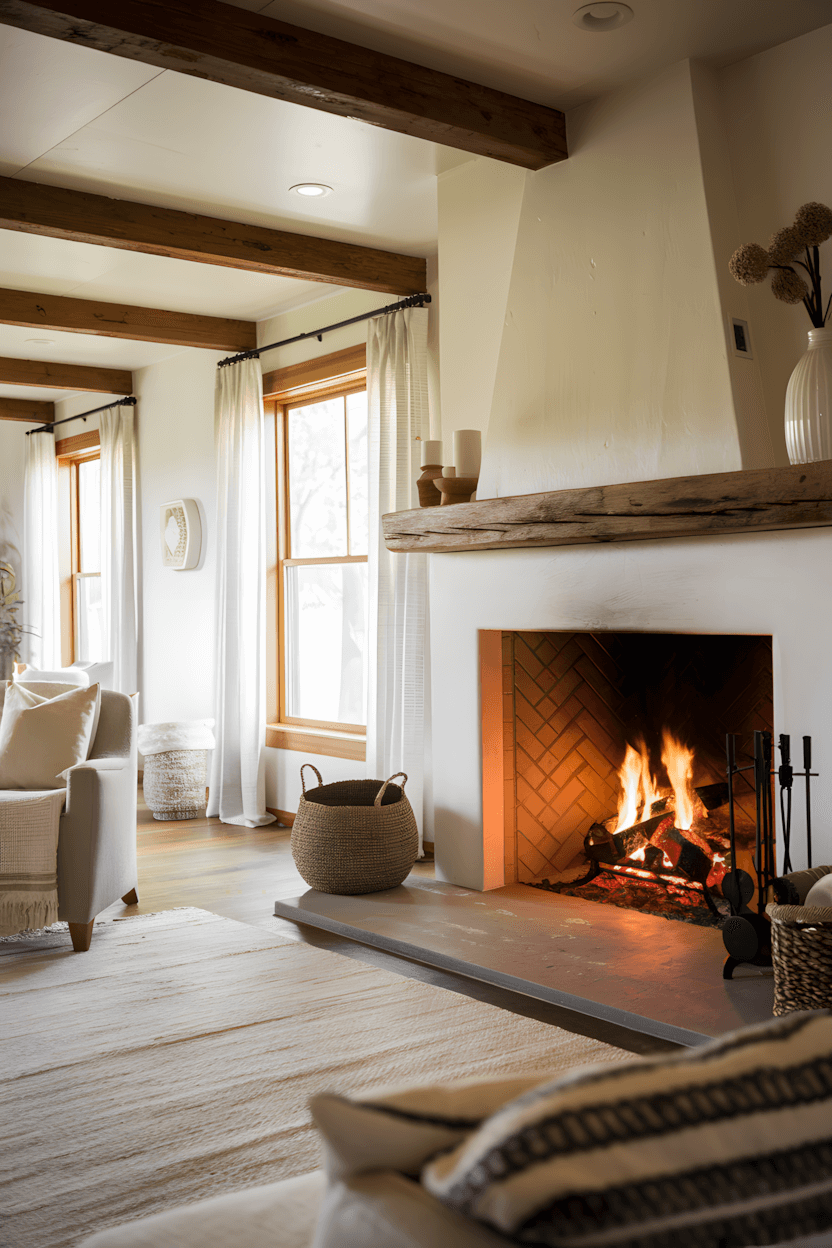
This approach combines natural materials with contemporary comfort. Fireplaces with wooden mantels can serve as focal points while exposed ceiling beams add architectural character.
Large windows with white curtains can brighten spaces while textured rugs add comfort on wooden floors. The combination often creates environments that feel both impressive and livable.
Material coordination: When combining rustic and modern elements, shared color palettes or finishes often help create cohesive results.
16. Elegant Neutrals with Natural Accents
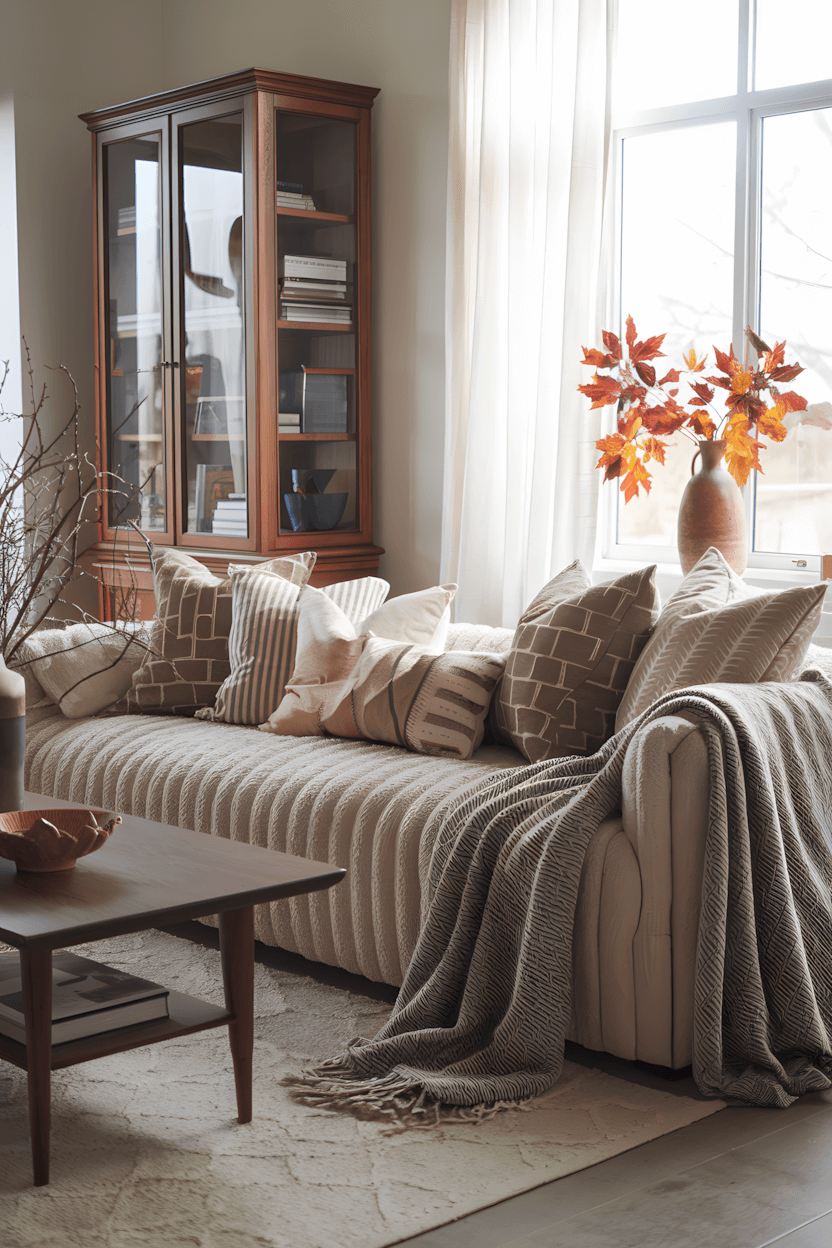
This approach uses sophisticated neutral palettes with organic touches. Wooden display cabinets can provide both storage and showcase opportunities while maintaining visual warmth.
Patterned cushions and textured throws can add comfort layers while dried branches and natural accessories reinforce organic themes. Natural light through large windows enhances the warm color palette.
Natural accessories: Seasonal natural elements can be rotated to keep spaces feeling fresh while maintaining the organic aesthetic.
17. Spacious Modern with Statement Elements

This approach works well in larger spaces requiring dramatic focal points. Modern chandeliers can provide both illumination and artistic interest while stone fireplaces add substantial architectural presence.
Multiple decorative elements—artwork, baskets, plants—can personalize large spaces while maintaining organized arrangements. The combination appeals to those wanting impressive, well-appointed environments.
Large space strategy: Substantial rooms often benefit from multiple focal points and varied lighting sources to prevent feeling empty or cold.
18. Luxurious Contemporary with Refined Details

This approach emphasizes sophisticated materials and finishes. Tufted ottomans can provide both seating and surface space while black coffee tables add contemporary contrast.
Coordinated artwork and carefully selected accessories can create polished looks while recessed lighting provides even illumination. The combination typically appeals to those wanting refined, upscale aesthetics.
Luxury considerations: High-end finishes often require more maintenance and care to preserve their appearance over time.
Creating Your Perfect Living Room Environment
Based on various homeowner experiences, successful living room design often happens when you choose approaches that genuinely reflect your lifestyle and daily routines rather than simply following current trends.
Consider how you actually use the space—do you entertain frequently, have children or pets, or primarily use the room for quiet relaxation?
The most functional living rooms typically balance aesthetic appeal with practical considerations like maintenance requirements, traffic flow, storage needs, and lighting for various activities.
Start by honestly assessing your space constraints, natural light conditions, and daily use patterns, then consider which approaches might work within those realities.
Remember that living rooms serve as central gathering spaces for years, so choosing designs that will remain functional and appealing as your needs evolve often provides better long-term satisfaction than focusing solely on immediate visual impact.
Final reminder: Living room renovations may involve electrical work, structural modifications, or specialty installations that require licensed professionals. Always consult appropriate contractors and obtain necessary permits to ensure safety and code compliance.

